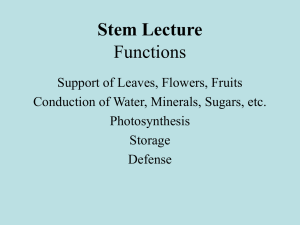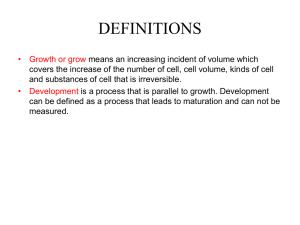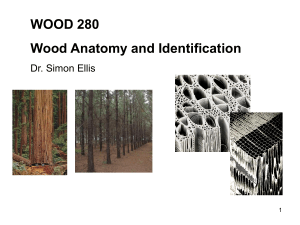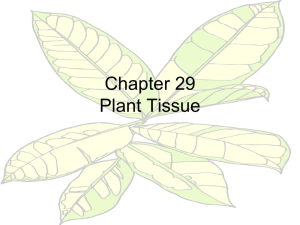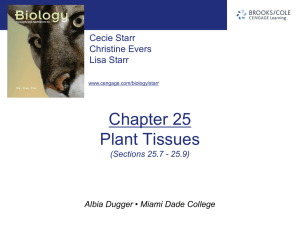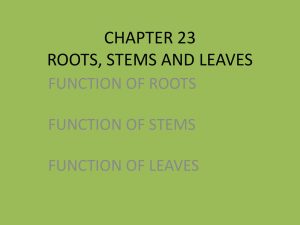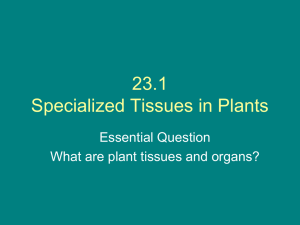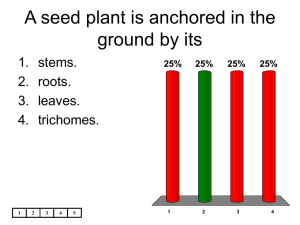Document
advertisement
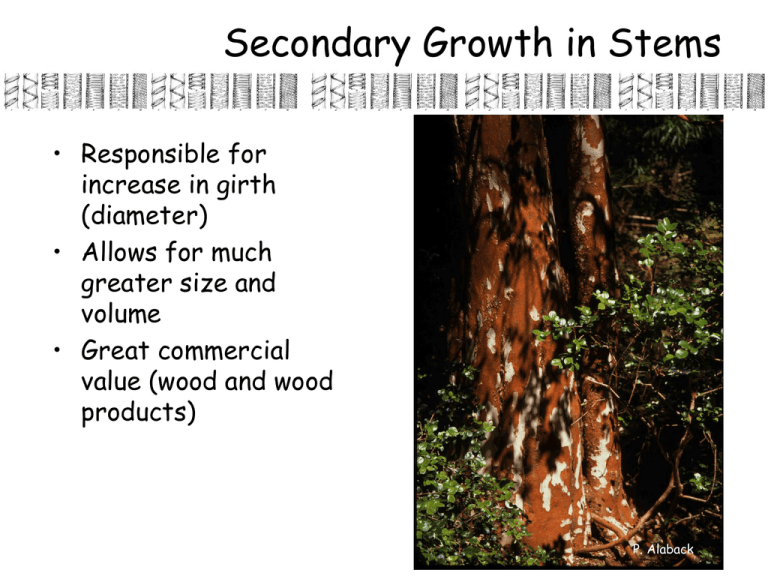
Secondary Growth in Stems • Responsible for increase in girth (diameter) • Allows for much greater size and volume • Great commercial value (wood and wood products) P. Alaback Vascular cambium 1. Lateral meristem forming vascular tissues 2. Innermost layer of bark, between the xylem and phloem tissues. 3. Grows both to the inside and to the outside • • 4. http://www.esb.utexas.edu/mauseth/weblab/webchap3par/3.2-5.htm cells on inside = secondary xylem cells to outside = secondary phloem. NOTE: secondary differentiates these new tissues from the primary xylem and phloem, which derive from the apical meristem Derivation from the Apical Meristem http://mason.gmu.edu/~jlawrey/biol304/biol304/notes/Image18.gif Anatomy of the Vascular Cambium A. Technically vascular cambium = cambial initials 1. difficult to distinguish between initials and their derivatives 2. refer to a cambial zone B. vascular cambium meristematic cells - highly vacuolated 1. Fusiform initials - vertically elongated 2. Ray initials - horizontally elongated or squarish C. Two possible planes of cell division 1. Periclinal division = new cells in front or behind the other a. Yields 2o xylem and phloem b. New cells toward the inside = xylem; cells to the outside = phloem 2. Anticlinal division = cells side by side. a. adds new cells to the vascular cambium as stem grows in girth Fusiform vs. ray initials Fusiform and ray cells form FILES of cells – each file contains a number of differentiating elements. AXIAL Axial: Longitudinal translocation, xylem & phloem elements. Fusiform Radial: Lateral translocation. Carbohydrate from phloem, to parenchymatic (living) tissue, water from xylem to living tissues as well. Endarch tangential face Exarch tangential face RADIAL face Ray Exarch tangential face RADIAL face http://anubis.ru.ac.za/virtualplant/Powerpoint/cambial%20grow.ppt •Produces the radial (lateral) transport system cells •In xylem and phloem these are the parenchyma •Produces the axial (vertical) transport system cells •In xylem and phloem these are the sieve-tube member, companion cells, tracheids, vessels, and fibers •Can be storied (more advanced; less common) or nonstoried Nonstoried Fusiform Initials Storied Fusiform Initials Plant Anatomy CD Vascular Cambium A. Technically vascular cambium = cambial initials 1. difficult to distinguish between initials and their derivatives 2. refer to a cambial zone B. vascular cambium meristematic cells - highly vacuolated 1. Fusiform initials - vertically elongated 2. Ray initials - horizontally elongated or squarish C. Two possible planes of cell division 1. Periclinal division = new cells in front or behind the other a. Yields 2o xylem and phloem b. New cells toward the inside = xylem; cells to the outside = phloem 2. Anticlinal division = cells side by side. a. adds new cells to the vascular cambium as stem grows in girth Activity of the Vascular Cambium 1. cambium active from spring to fall; inactive in winter • Larger xylem produced in spring vs fall • Lead to gradual reduction in size of xylem 2. Pattern of yearly activity produces annual rings in the xylem 3. Generally the xylem-producing cells are more active than the phloem-producing cells Development of the Vascular Cambium A. function is to produce secondary growth, 1. vascular cambium must be formed before secondary growth can occur B. Two regions of primary stem contribute to the vascular cambium 1. Fasciscular cambium - meristem cells within vascular bundle 2. Interfascicular cambium - meristem cells between vascular bundles Development of secondary vascular tissues During primary growth, the vascular bundles produce PRIMARY vascular tissue. These are the primary phloem (proto + meta) and primary xylem (proto and meta). The fascicular cambium separates the two tissues. Remember: a fascicle is a vascular bundle http://anubis.ru.ac.za/virtualplant/Powerpoint/cambial%20grow.ppt 1. Development commences at the fascicular cambium http://anubis.ru.ac.za/virtualplant/Powerpoint/cambial%20grow.ppt Establishment of Vascular Cambium Trifolium Stem Plant Anatomy CD First activity is in the vascular bundle 2. FCZ = fascicular cambial zone Secondary xylem Secondary phloem FCZ Secondary xylem and phloem are produced by the fascicular cambium http://anubis.ru.ac.za/virtualplant/Powerpoint/cambial%20grow.ppt Transverse Vascular Cambium 2o Xylem 2o phloem with callose Radial 3 The interfascicular regions begins to develop a cambium. http://anubis.ru.ac.za/virtualplant/Powerpoint/cambial%20grow.ppt The interfascicular cambial area in herbaceous stems does not activate, thus does not produce new phloem or xylem tissues PX MX 2X 2P PPF CZ 1P 3b 3a A widening band of secondary vascular tissue results. CZ 4 http://anubis.ru.ac.za/virtualplant/Powerpoint/cambial%20grow.ppt http://www.uri.edu/artsci/bio/plant_anatomy/107.html The functional vascular cambium 1. Becomes vascular cambium when the fascicular and interfascicular cambium join to form a complete cylinder around the stem 2. As soon as the cylinder is formed, vascular cambium becomes active a. divides on both the inner and outer surface of the vascular cambium surfaces. 3. Activity of the vascular cambium a. New xylem cells are formed inwardly and attached to the previously produced xylem b. New phloem cells are formed outwardly and are attached to the previously produced phloem The ring of secondary tissue is Complete. The interfascicular and fascicular cambia together form a vascular cambium http://anubis.ru.ac.za/virtualplant/Powerpoint/cambial%20grow.ppt http://botit.botany.wisc.edu:16080/images/130/ What happens when a porcupine “girdles” a tree? http://botit.botany.wisc.edu:16080/images/130/ Porcupines break through the outer bark, usually near the top of a tree, and eat the phloem.This damages the vascular cambium and may lead to the death of the tree. http://www.biologie.uni-hamburg.de/b-online/library/webb/BOT201/Angiosperm/MagnoliophytaLab99/Oak3DColrLab500.jpg Time for a Break! What You See in Different Sections: Orienting You For Lab 1. Transverse - cross section through middle: 1. 2. end of vessels, tracheids and fibers Long dimensions of rays 1. 2. 3. Looking at the face of the vascular cambium! Long sides of vessels Rays are in cross section (see their ends) 1. 2. Long sides of fibers, vessels, and sides of rays Rays look like streaks running at right angles across the lengthwise vessels and tracheids 2. Tangential - perpendicular to radius of stem: 3. Radial - cut parallel to direction of rays along radius of stem: Understanding Sections Tilia Stem (linden) Tangential Cross Section Radial Tilia Stem (linden) Cross Section vessels (1) tracheids (2), libriform fibers (3), axial parenchyma (4) and (5) uniseriate rays(6) Multiseriate rays (7) Tilia Stem (linden) Tangential 1 = tracheids with numerous tiny bordered pits in their radial walls 2 = libriform fibers 3 = axial parenchyma 4 = narrow rays Tilia Stem (linden) 1 = vessel 3 = libriform fibers 5 and 6 rays 2 = tracheids 4 = axial parenchyma Radial What Kind of cell makes up the bulk of a tree? NEXT WEEK WOOD
